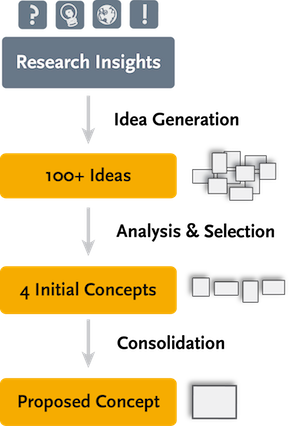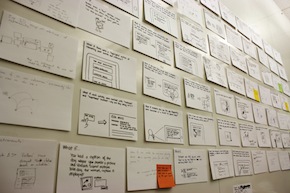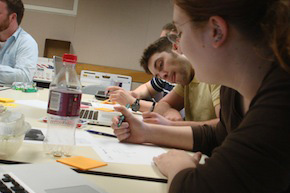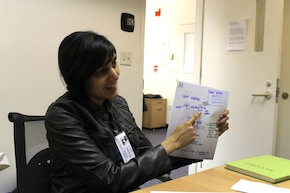Team Pyxis
Building on our user research, we generated over 100 ideas, distilled them down to four possible concepts, and then consolidated the four to one final concept.
At the end of the last semester, our team left Pittsburgh with over 70 rough ideas that we came up with while considering our research insights in a rapid brainstorming session. Armed with those ideas and the three design directions that we derived from them, we arrived to NASA Ames with several paths we could take our design. We immediately picked up where we left off, and continued a process of idea generation to create more defined visions of the application. In the end we had over 100 ideas, which we then began analyze and filter to create an initial concept.
The process of analysis and selection kicked off the second stage of our visioning process during which we shared our ideas with colleagues, peers, and faculty who provided critiques and feedback. We used their feedback to pick apart and combine our ideas until we arrived at a final concept through consolidation. The concept was derived from the findings we gained from user research, the data we would have available to us, and through the consideration of technical constraints we face.

-
Rapid Brainstorming
Fresh with our research research in mind, we sat down and quietly sketched out any ideas on small cards, phrasing our ideas in the form of “What if...?” statements. We ended up with over 70 ideas, which were synthesized down to four concept directions and used as starting point for our design.

The 70 postcards of rough sketches and ideas were generated from rapid brainstorming.
-
Persona-Based Design Studio
The standard design studio method consists of five stages: illuminate, sketch, present, critique, and iterate. The iterations are first done individually and then as a group, and the goal of this process is to arrive at some solid design solutions in a collaborative setting. We modified the design studio process to be persona-centric to focus our design towards our target users. Our main variation was having a persona-centric illumination where all participants were given a summary sheet of a particular persona they are in charge of. With the help of this summary sheet, participants became the evangelist of their given persona, sketching out solutions that persona would like to see and critiquing other ideas based on their persona's needs.

Mentors at NASA Ames Research Center discussing user needs during the design studio session.
-
Brainwalking
In the process of narrowing down our vision, we conducted a brainwalking activity that allowed us to build on top of each others’ ideas. The activity starts with the team sitting in a circle; everyone then writes or sketches one to two ideas on letter-sized papers. Whenever the timer hit five minutes, each person stopped sketching and passed what they had to the person next to them in a clockwise fashion. After each pass, they would work off of what has been passed to them, either continuing the idea or creating a new idea sparked by what they see. They then stop after another five minutes and pass down what you have again.

A member of our team talks about the idea she came up with after all the sketches were passed around twice.


